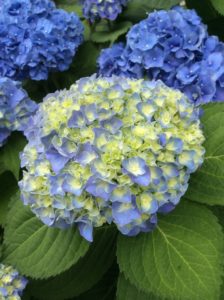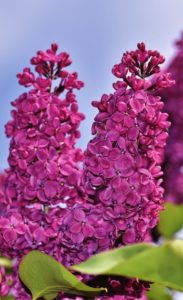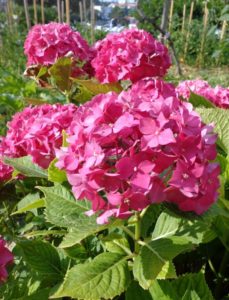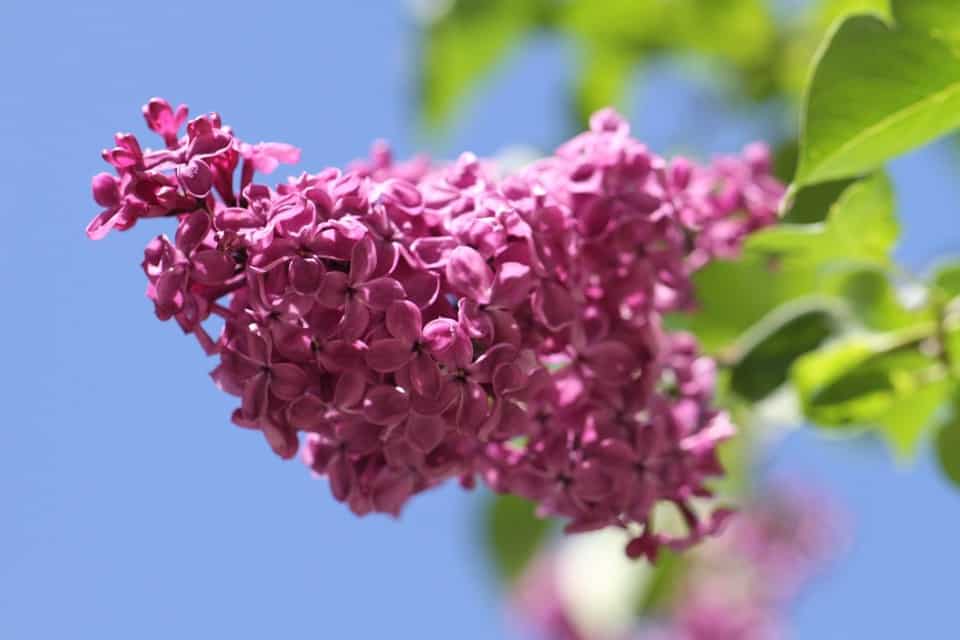Some links in the post are affiliate links and I get a commission from purchases made through some links found in the post.
For that ‘wow’ factor in your summer garden you may automatically think of hydrangeas. These can be truly spectacular when they bloom in all their glory.
Hydrangeas can grow up to around 15 feet in height in the right conditions and come in several beautiful colors. These can be altered using baking soda, check out our article on how to use baking soda to grow hydrangeas.
Not only are they hardy, but they are low maintenance once established.
Before you think that these are the only plants for the summer, you may want to consider adding some lilacs into your garden. Lilacs, just like hydrangeas can bring an extra beauty to any space they are placed.
There are some differences between hydrangeas and lilacs, but both can enhance a garden in their own way.
Hydrangeas vs Lilacs – What are the Similarities?

Both the hydrangea and the lilac are classed as perennial, so they seem to die back at the end of the growing season and start up again in early spring.
Both plants have colors such as blues, purples, reds, and whites and both are classed as flowering shrubs.
These plants both need soil which drains well, they cannot tolerate soggy roots and mushy soil. They both bloom in spring and early summer, although the hydrangea will last till the end of summer.
Both plants are considered medium maintenance, and both need regular watering. In extremely dry, hot temperatures both will need extra water during the day.
In the spring both will need moderate watering and in the winter they will need watering once a week. To help you with your hydrangea watering needs we have an article here.
The soil requirement for these plants is acidic for hydrangeas and acidic to neutral for lilacs. To
Both the hydrangea and the lilac are drought tolerant, and both can be given an all-purpose fertilizer. Neither of these plants has thorns.
Hydrangeas vs Lilacs – What are the Differences?
One of the main differences is the height they grow to. Hydrangeas can reach huge heights and widths.
In ideal conditions hydrangeas can reach anything up to 15’ while the average lilac is very seldom more than a few inches off the ground.
Leaf shapes differ with the hydrangea being lobed, glossy and slightly leathery and the lilac a heart-shape.
Hydrangea leaves are lighter green while lilac leaves are darker green. In fall hydrangea leaves change from green to yellow or yellow/green. Lilac leaves turn from green to yellow and then to sandy brown.
Hydrangeas originate from China, Japan, Korea and Indonesia and lilacs come from Europe and North America.
There are just less than 100 varieties of hydrangea, while lilacs number about 1000 different varieties.
Hydrangeas can live in forest areas, hillsides and in woods, with lilacs preferring roadsides and rocky areas.
Planting times differ with hydrangeas planted in early spring and even in Autumn. Lilacs need to be planted in mid spring to late spring.
One of the most noticeable differences is where these plants need to be situated.
Hydrangeas need early morning sun and then partial shade, while lilacs will do well in full sun for most of the day and partial shade late in the afternoon.
Hydrangeas need light soil to do well, while lilacs need loamy/sandy soil. Lilacs are considered medium growers while hydrangeas are fast growers.
As far as pests and diseases go, hydrangeas have issues with leaf spot, root rot and powdery mildew while lilacs are attacked by slugs, snails and suffer from powdery mildew.
If you are looking to attract wildlife to your garden then hydrangeas will bring bees and flies, while lilacs attract butterflies and hummingbirds. If you are interested in that, check out our article on do marigolds attract bees?
An interesting point here for allergy sufferers:
Hydrangeas can cause chest tightness, nausea, and dizziness while lilacs may cause eye irritation, itchy eyes, and runny nose.
Additionally, hydrangeas are used in making air fresheners and the oil is often used in perfume, soaps, and creams.
Lilacs are used in the food industry as well as in the perfume industry.
Hydrangeas vs Lilacs – Where is the Best Place to Plant Them?
Hydrangeas enjoy the early morning sun but do not do well in the hot afternoon sun. They prefer to be sheltered during the heat of the afternoon.
Even a dappled shade will suit hydrangeas, as long as the soil is well draining. Avoid any south-facing area and more so if the soil is dry there as the hydrangea will not fare well.
If you really need to plant a hydrangea in a shaded spot such as a north facing wall then you may think about the climbing variety Hydrangea anomala subsp. Petiolaris.
Lilacs, on the other hand, love the full sun and will be very happy with between 6-8 hours of sun each day. If they do not have enough sun, they will simply not bloom.
You definitely should not plant lilacs in an area where they will be shaded for more than half a day.
Lilacs can be planted up against the house because their roots are not invasive. The roots will only spread to one and a half times the width of the plant.
Your lilacs will be happy as long as you give them place to grow and spread so be sure to leave adequate space between plants.
If you are enjoying this article, check out our article on why does my hydrangea have small flowers.
Hydrangeas vs Lilacs – What is their Lifespan?
Hydrangea bushes can live up to about 50 years under the right conditions and with correct care and maintenance.
Lilacs are considered super hardy and will last for anywhere up to 75 years – and possibly more if taken care of correctly.
Hydrangeas vs Lilacs – What are their Best Growing Conditions?

In the USA hydrangeas bloom and grow best in zones 5-9. If well maintained in these zones you could see healthy huge plants for decades, blooming every spring and summer.
Hydrangeas do very well on regular store-bought compost although if you want those beautiful blue flowers you may want to use ericaceous compost instead.
Lilacs will thrive in the USA in zones 3-7 and will also last many years if cared for correctly.
These plants will thank you for adding grass clippings and coffee grounds around than as they are good sources of nitrogen.
Use sparingly because if there is too much nitrogen in the soil, the blooms will be reduced. You can also add bone meal to the soil.
It’s all about drainage
Both the hydrangea and the lilac will suffer if they do not have good drainage. Neither plant does well with soggy roots and wet soil around them and both will suffer if either the pot or the ground does not drain well.
How to test the drainage
Here’s an easy way to ascertain if the area you want to place your plant has suitable drainage.
Dig a hole which is about 8 inches in diameter and about 12 inches deep. Fill the hole with water.
If, after one hour the water has not completely drained away, the soil is not suitable for either hydrangea or lilac so you will need to find another spot for your plants.
Hydrangeas vs Lilacs – How Many Varieties are There?
Sources vary about how many varieties exist of hydrangeas, with some saying that there are in the region of 23 species and others claiming that there are as many as 80.
In the US, however, there are only six types which are known to grow there in gardens.
Lilacs, which belong to the Oleaceae family come from a genus of between 20-25 flowering species and have been recorded to have more than 1000 varieties of the bush.
You may also like: Wisteria vs Lilac
What is a Good Companion Plant for Lilacs?
Because lilacs tend to be smaller and lower to the ground there are many taller companion plants for them.
Peonies of all types make great companions for lilacs. They colors seem to always go together as do the gentle fragrance from both plants.
The base of the peony does not look particularly glamourous but when lilacs are placed at the base, the entire plant looks more attractive.
Lilacs also look great when grown in among bulbs like tulips, daffodils and hyacinth which multiply each year – a huge bonus as it means less or no weeds in that area.
What is a Good Companion Plant for Hydrangeas?
Because hydrangeas grow tall they do not show off any small plants around their bases. However, when paired with plants such as boxwood and azaleas, the hydrangea comes into its own.
Gardenia and holly plants look stunning when planted near hydrangea, as do ferns, hostas, and foxgloves.
Because the hydrangea is such an impressive plant it needs to have plants of equal body nearby other wise it will simply overshadow a smaller and more delicate plant such as the lilac.
Can I Propagate Hydrangeas and Lilacs?
Hydrangeas
Hydrangeas are easy to propagate by simply taking a cutting from a healthy plant.
Make sure that the cutting is 5-6 inches in length. Some experts suggest that the cutting should be taken from a branch which has not flowered that year.
Dip the cutting in a rooting hormone and insert it into your growing medium. This can be potting mix, coarse sand, or vermiculite. Make sure that the medium is sterile to prevent infection.
Lilacs
There are two ways to propagate lilacs, namely in water and directly into the ground.
For propagating in water take a cutting from a healthy plant and place in a glass of water. Fill with about 2 inches of water. Keep the water topped up and you will soon have small leaves forming.
To propagate directly into the ground, take a cutting from a healthy plant. Dig a hole deep enough for the cutting and place the cutting into the soil. Back fill with soil and leave it. It roots in no time and soon you will have new growth.
Can I Grow Hydrangeas and Lilacs in Pots?
Both can be grown in pots. In fact, growing plants in pots is a great idea as they can be moved to better conditions if they are not doing well.
Growing them together in pots may not be the best idea as hydrangeas tend to overpower the delicate lilac plant with their sheer size and volume.
Lilacs are best grown in pots with similar sized plants or bulbs so that they all bring out the best in each other.
Hydrangeas are best kept alone in their pot because they will soon fill it and overpower other plants.
Either way, planting these plants in pots can make a beautiful addition to an otherwise dull and uninteresting patio. To help you we have an article on the common problems with hydrangeas in pots.
As long as you pay attention to good drainage for both plants and move then to the best sun/shade conditions, there is no reason why they should not thrive in pots.
Hydrangeas vs Lilacs – Are they Bad for Animals?
 Before you plant anything in your garden it is a good idea to ask this question. Not only can this affect your pets, but it can also harm children.
Before you plant anything in your garden it is a good idea to ask this question. Not only can this affect your pets, but it can also harm children.
The leaves, buds, flowers, and bark of the hydrangea all contain cyanogenic glycoside which is the toxic component in the plant. If you dog chews any part of the plant they will become ill.
On the other hand, lilacs do not contain any part or any chemical that is harmful to humans or animals.
Even though this is the case with lilacs, it is never a good idea to let dogs chew any part of the plant in case they learn that they can chew other plants in the garden.
Likewise, children should be kept away from plants that can harm them.
Final Thoughts
Both hydrangeas and lilacs make beautiful additions to a garden, and with the right care and maintenance, both will reward you will many years of beauty and delight, particularly when you combine them with other plants that offset them.
Both plants, with the right attention will live for many years and both plants can easily be propagated for extra plants in your garden.
These two garden additions are not only beautiful, but they are also low maintenance, so there is no reason why they should not become additions to your garden.
Before you go, here are some more related articles I encourage you to read below to help solve more of your gardening issues:
How to landscape with hydrangeas
How to prevent leaf scorch on your hydrangea
How do you get Rid of Black Spots on Hydrangea Leaves
Why Are My Hydrangea Leaves Curling & How to Fix Them


